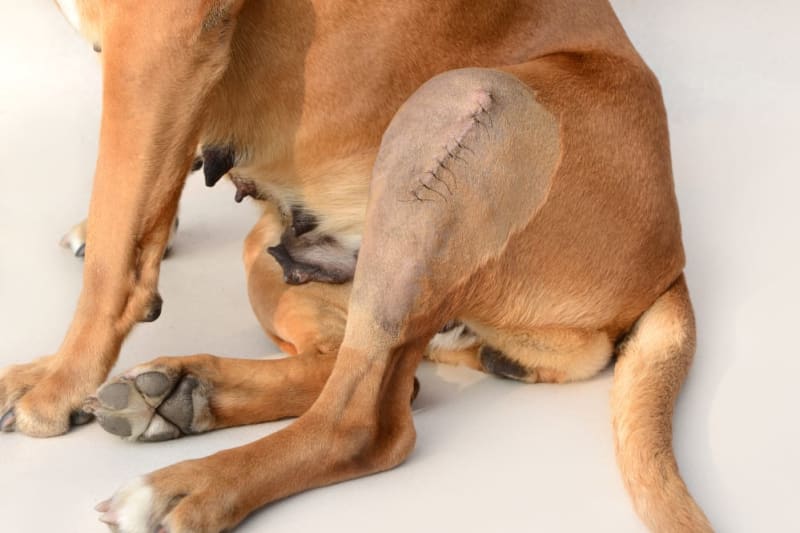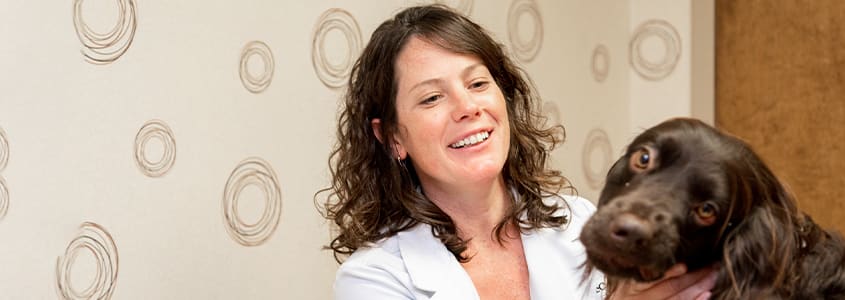It's critical for pet parents to understand how to care for their dog after surgery so that their pooch can return to a normal, active lifestyle as soon as possible. Here are some pointers from our Greensboro veterinarians on how to care for your dog after surgery.
Always Follow Your Veterinarian's Post-Op Instructions
Surgery is bound to be a stressful time for pet parents and pets alike, but knowing how to look after your dog when they get home from surgery is important for helping your dog get back to normal as quickly as possible.
Following your dog's surgery, the veterinary surgeon, vet, or veterinary nurse will give you detailed instructions on how to care for your pet at home. It is critical to carefully follow your veterinarian's instructions. If you have any questions, please do not hesitate to ask! Even if you get home and realize you forgot to follow a specific instruction, contact your veterinarian for clarification. Your veterinary team wants the best for your dog and will gladly assist you in understanding the post-op instructions you have been given.
Here are a few basic tips that can help you to keep your pet comfortable and safe as they recover at home:
After-Effects of General Anesthetic
The majority of veterinary surgical procedures will necessitate the use of a general anesthetic. A general anesthetic renders your pet unconscious and prevents them from feeling any pain during the procedure; however, the general anesthetic may take some time to wear off after the surgery. A general anesthetic may cause your dog to feel sleepy or shaky on its feet for a short period of time. These side effects are normal and should go away quickly with rest. A temporary loss of appetite is another common side effect of a general anesthetic.
Feeding Your Dog After Surgery
A general anesthetic may make your dog feel nauseous, and your dog may refuse to eat after surgery. When it comes to feeding your dog after surgery, a half-size portion of a light meal, such as chicken and rice, can be easier to digest than regular store-bought dog food. Your dog's appetite should return within 24 hours of surgery, at which point you can gradually resume serving their regular food. If your dog does not eat for 48 hours after surgery, contact your veterinarian or veterinary surgeon. Loss of appetite can indicate pain or infection.
Managing Your Dog's Pain After Surgery
When your dog is ready to go home after surgery, a veterinary professional will explain the medications prescribed to manage your dog's post-surgery pain. They will explain the dosage, how frequently to give your dog the medications, and how to administer the medications. Follow your vet's instructions to effectively prevent any unnecessary pain while your dog recovers without causing any side effects. If you have any questions about the instructions, please contact your veterinarian.
Antibiotics and pain medications are commonly prescribed for pets after surgery to help relieve post-op discomfort and prevent infections. If your pup suffers from anxiety or tends to be high-strung, your vet may also prescribe a sedative or anti-anxiety medication to help keep your dog calm while they are healing.
Never give human medications to your pet without consulting your veterinarian first. Many drugs that can help humans to feel better are toxic to dogs.
Keeping Your Dog Comfortable When They Get Home
It is critical to provide your pet with a comfortable and quiet place to rest after surgery, away from children and other pets. Giving your dog a soft, comfortable bed with plenty of room to spread out can help to prevent pressure on any bandaged or sensitive areas of their body.
Restricting Your Pet's Movement
After your dog's surgery, it is likely that your vet will recommend limiting your pup's activities and movement for a period of time. Sudden stretching and jumping movements can interfere with the healing process and may even cause the incision to reopen.
Fortunately, most operations do not necessitate significant confinement, such as complete 'crate rest,' and most pets do well with being kept indoors for a few days (with only essential trips outside for bathroom breaks). Having said that, it can be difficult to keep your dog from jumping up on furniture or climbing stairs. To prevent these behaviors for a few days, confine your dog to a safe and comfortable room when you are unable to directly supervise them.
Helping Your Dog When Cage Rest (Crate Rest) is Necessary
While most surgeries do not require crate-rest, orthopedic surgeries do often require strictly limiting your dog’s movements in order to help them recover well. If your vet recommends crate-rest for your dog following surgery, there are ways to help your dog adjust to this strict confinement so that they become more comfortable with spending long periods of time in a crate.
Make sure your dog's crate is big enough for him to stand up and turn around in. If your dog needs a plastic cone or 'E-Collar' to prevent licking, you may need to buy a larger crate for him to recover in. You'll also want to make sure there's enough room for their food and water dishes without risking spills that could be soiled and wet your dog's bedding and bandages.
Your Pet's Stitches
Many veterinarians now prefer to stitch the inside of your dog's wound rather than the outside. As the incision heals, the stitches on the inside dissolve. If your doctor uses outside stitches or staples, they will need to be removed by your doctor 10 to 14 days after surgery. Your veterinarian will inform you of the type of stitches used to close your pet's incision.
Caring for Your Pet's Incision Site
It can be challenging to keep your dog from biting, chewing, or scratching at their bandages or incision sites. To keep your dog from licking its wound, use a plastic cone-shaped Elizabethan collar (available in hard and soft versions). Many dogs adjust to wearing a cone collar quickly, but if your dog is having difficulty adapting to wearing a cone, there are other options available. Speak with your veterinarian about effective and less obtrusive options like donut-style collars or post-op medical pet shirts.
Keep Your Pet's Bandages Dry
Another important aspect of assisting your dog's incision to heal quickly is to keep bandages dry at all times. When your dog goes outside, cover the bandages with a plastic bag or cling wrap to protect them from damp or wet grass. When your pet returns inside, remove the plastic covering. If you leave the plastic over the bandage, sweat can collect under it and cause an infection.
Don't Skip Your Dog's Follow-Up Appointment
The follow-up appointment gives your vet the opportunity to monitor your pet's progress and check for any signs of infection before it becomes more serious.
It is also critical that your dog's bandages are not left on for an extended period of time after the procedure. Failure to change the bandages on time may result in pressure sores or even a disruption in the blood supply to the area. The staff at your pet's veterinary hospital has been trained to properly dress wounds. Bringing your dog in for a follow-up appointment allows your veterinary team to properly change your pet's bandages, which helps keep your dog's healing process on track.
Between veterinary appointments, if your dog's bandage falls off, or you notice swelling, blood seeping through the bandages, or an unpleasant odor at the incision site, make an appointment with your vet immediately.
Helping Your Pup to Stay Happy While Recovering
Dogs simply do not understand when they are in recovery and are likely to become frustrated by the decreased level of activity, the itchiness of their incision site, or the overall lack of stimulation following surgery, so it is critical that you provide stimulation and loving reassurance to your pet in other ways.
Amuse your pup with a rotating selection of gentle games that won't cause any stretching or jumping, such as dog-friendly chew toys or squeaky toys. Only give your dog one or two toys at a time, then switch to a different toy on a regular basis to help prevent boredom.
While treats can be a great way to cheer up your dog, it's important to keep in mind that your pup's reduced activity level means that they are burning fewer calories. Too many treats can equal too much of a good thing.
Remember that just taking some time out of your busy day to sit quietly with your pup, stroking their fur, and chatting with them calmly, can help your dog stay calm and feel loved.
Typical Recovery Times For Pets Following Surgery
Soft tissue operations, such as spaying, neutering, or abdominal surgery, usually result in a faster recovery than procedures involving bones, joints, and ligaments. Many soft tissue surgeries heal about 80% after 2-3 weeks and may be completely healed in about 6 weeks.
Surgeries involving bones and ligaments will likely take much longer to heal and are usually around 80% healed after about 8 - 12 weeks, although it can take as long as 6 months for your pet to recover completely following surgeries such as those to repair a torn cruciate ligament (ACL).
Reassurance for Loving Pet Owners
Pet parents frequently feel guilty about limiting their dog's movements following surgery. However, keep in mind that dogs recover much faster from surgery than humans do, and by following your vet's post-op instructions, you are doing everything you can to help your dog recover quickly and return to their normal active lifestyle as soon as possible!
If you notice your dog shaking or coughing after surgery, there's usually no cause for alarm. A post-surgery cough is usually normal a few days after surgery. If it persists past the three-day mark, though, contact your vet.
If you're concerned about your dog's recovery from recent surgery, contact us for assistance. Our veterinary professionals at Guilford-Jamestown Veterinary Hospital in Greensboro are here to help your pet feel better.
Looking for a vet in Greensboro?
We're always accepting new patients, so contact our veterinary hospital today to book your pet's first appointment.
Related Articles View All
Importance of Parasite Control in Dogs & Cats
Parasites pose a serious risk to the health and longevity of pets throughout Greensboro and surrounding areas, but preventing parasites has never been easier. How do parasites affect your dog or cat's health? How are parasites prevented? Read on to find out.
How often and when should you take a cat to the vet?
You want to give your kitty all the love and care they need to thrive, but when it comes to veterinary care you find yourself a little lost. How often should you take a cat to the vet? Well, that depends. Read on to learn more.
Miliary Dermatitis in Cats - Scabby Cat Disease
Miliary dermatitis is an allergic reaction seen in cats that causes your feline friend's skin to feel 'scabby' and irritated, which is why the condition is widely known as scabby cat disease. Today, we discuss miliary dermatitis in cats, its causes, and treatment.


